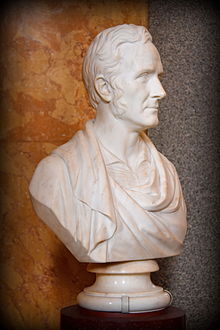Robert Smirke (architect)
| Sir Robert Smirke | |
|---|---|
 |
|
| Born |
Robert Smirke 1 October 1780 London |
| Died | 18 April 1867 (aged 86) Cheltenham, Gloucestershire |
| Nationality | English |
| Occupation | Architect |
| Awards | Royal Gold Medal (1853) |
| Buildings | The British Museum |
Sir Robert Smirke RA (1 October 1780 – 18 April 1867) was an English architect, one of the leaders of Greek Revival architecture, though he also used other architectural styles. As architect to the Board of Works he designed several major public buildings including the main block and facade of the British Museum. He was a pioneer of the use of concrete foundations.
Smirke was born in London on 1 October 1780, the second son of the portrait painter Robert Smirke; he was one of twelve children. He attended Aspley School, Aspley Guise, Bedfordshire, where he studied Latin, Greek, French and drawing, and was made head boy at the age of 15. In May 1796 he began his study of architecture as a pupil of John Soane but left after only a few months in early 1797 due to a personality clash with his teacher. He wrote to his father:
He (Soane) was on Monday morning in one of his amiable Tempers. Everything was slovenly that I was doing. My drawing was slovenly because it was too great a scale, my scale, also, being too long, and he finished saying the whole of it was excessively slovenly, and that I should draw it out again on the back not to waste another sheet about it.
In 1796 he also began his studies at the Royal Academy winning the Silver Medal that year, also winning the same year the Silver Palette of the Royal Society for the encouragement of Arts, Manufactures & Commerce, he was awarded the Gold Medal of the Royal Academy in 1799 for his design for a National Museum. After leaving Soane he depended on George Dance the Younger and a surveyor called Thomas Bush for his architectural training. In 1801, accompanied by his elder brother Richard he embarked on a Grand Tour which would last until 1805. His itinerary can be followed by the series of letters he wrote: Brussels, Paris (in order to visit which the brothers had to disguise themselves as Americans as Britain was at war with France at the time), Berlin, Potsdam, Prague, Dresden, Vienna. He visited Italy, including, Florence, Venice, Padua, Genoa, Vicenza, Rome, Naples, and Sicily, then went on to Greece, seeing Corinth, Athens, Delphi, Thebes and Olympia. From Athens Smirke wrote to his father:
...
Wikipedia
